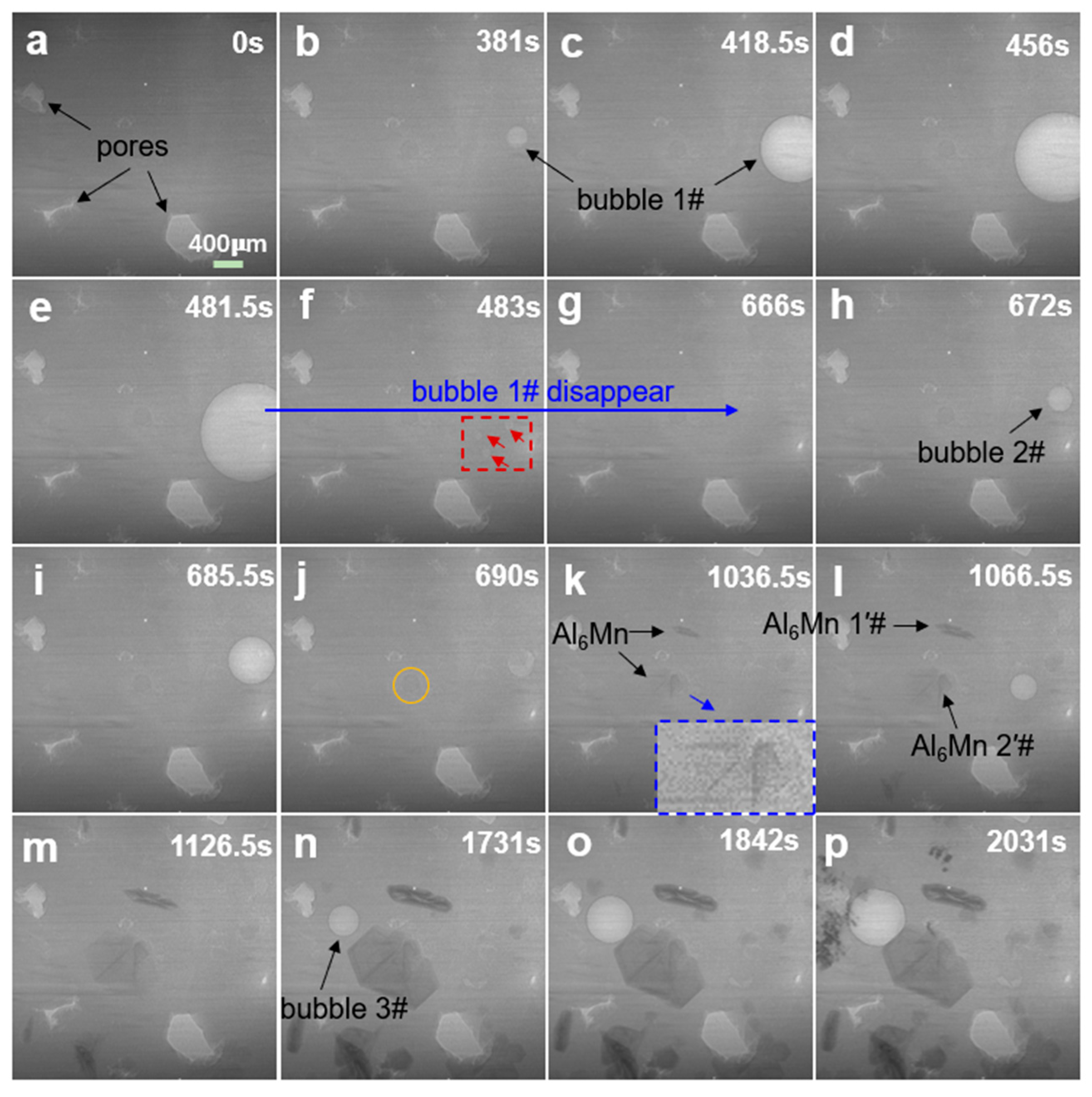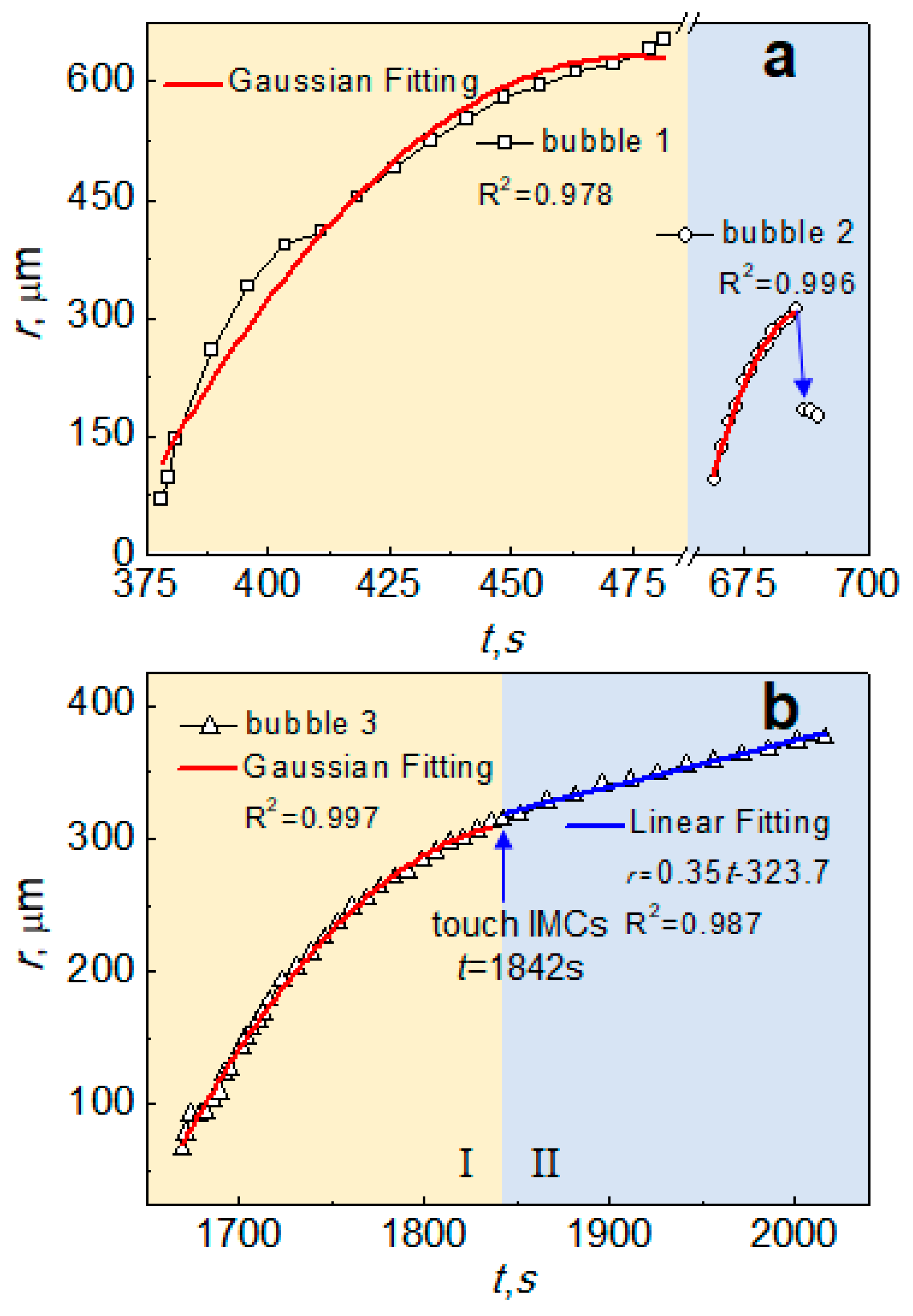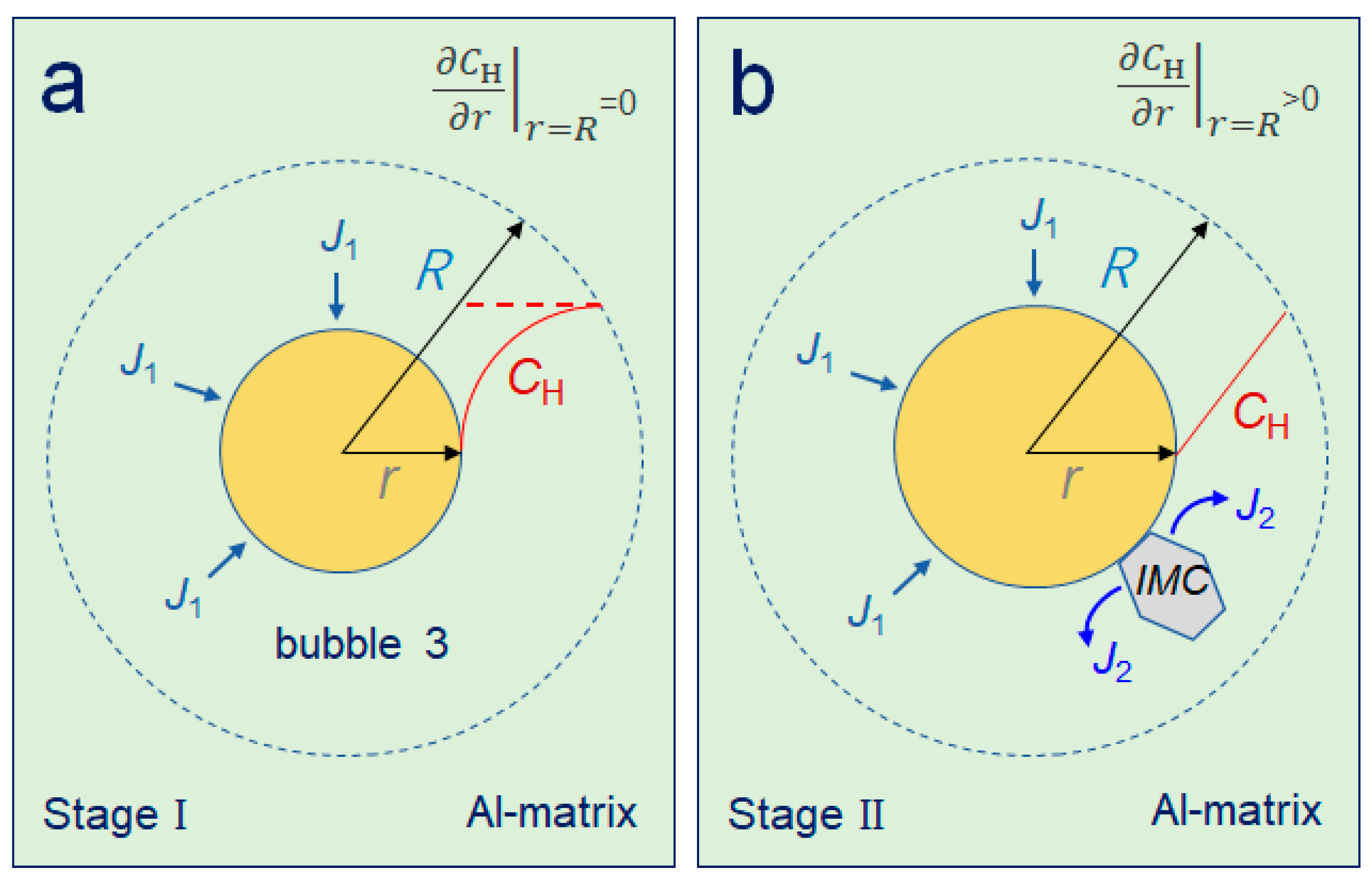Growth Behaviors of Bubbles and Intermetallic Compounds in Solidifying Al-5 wt.% Mn Alloy
Abstract
1. Introduction
2. Materials and Methods
3. Results and Discussion
3.1. Growth Behavior of Bubbles
3.2. Growth Mechanism of Al6Mn IMCs
4. Conclusions
Author Contributions
Funding
Data Availability Statement
Acknowledgments
Conflicts of Interest
References
- Kang, H.; Li, J.; Wang, T.; Guo, J. Growth Behavior of Primary Intermetallic Phases and Mechanical Properties for Directionally Solidified Al-Mn-Be Alloy. Acta Metall. Sin. 2018, 54, 809–823. [Google Scholar]
- Kang, H.; Li, X.; Su, Y.; Liu, D.; Guo, J.; Fu, H. 3-D Morphology and Growth Mechanism of Primary Al6Mn Intermetallic Compound in Directionally Solidified Al-3 at.% Mn Alloy. Intermetallics 2012, 23, 32–38. [Google Scholar] [CrossRef]
- Bouché, K.; Barbier, F.; Coulet, A. Intermetallic Compound Layer Growth between Solid Iron and Molten Aluminium. Mater. Sci. Eng. A 1998, 249, 167–175. [Google Scholar] [CrossRef]
- Kang, H.; Wang, T.; Li, X.; Su, Y.; Guo, J.; Fu, H. Faceted–Nonfaceted Growth Transition and 3-D Morphological Evolution of Primary Al6Mn Microcrystals in Directionally Solidified Al–3 at.% Mn Alloy. J. Mater. Res. 2014, 29, 1256–1263. [Google Scholar] [CrossRef]
- Lu, W.; Zhang, N.; Ren, N.; Ding, Z.; Yang, F.; Hu, Q.; Li, J. Bubble-Induced Formation of New Intermetallic Compounds in an Al-Mn Alloy during Heating Observed by Synchrotron Radiography. Materialia 2021, 15, 100991. [Google Scholar] [CrossRef]
- Lu, W.; Zhang, N.; Ding, Z.; Yang, F.; Hu, Q.; Zeng, L.; Li, J. Bubble Growth, Intermetallic Compounds Dissolution and Their Interactions during Heating of an Al-5 wt.% Mn Alloy by in-Situ Synchrotron Radiography. J. Alloys Compd. 2020, 822, 153554. [Google Scholar] [CrossRef]
- Chen, Z.; Hou, Y.; Xie, B.; Zhang, Q. Dendrite Morphology Evolution of Al6Mn Phase in Suction Casting Al–Mn Alloys. Materials 2020, 13, 2388. [Google Scholar] [CrossRef]
- Qiao, Y.; Ma, H.; Yu, F.; Zhao, N. Quasi-in-Situ Observation on Diffusion Anisotropy Dominated Asymmetrical Growth of Cu-Sn IMCs under Temperature Gradient. Acta Mater. 2021, 217, 117168. [Google Scholar] [CrossRef]
- Chen, F.; Mao, F.; Chen, Z.; Han, J.; Yan, G.; Wang, T.; Cao, Z. Application of Synchrotron Radiation X-Ray Computed Tomography to Investigate the Agglomerating Behavior of TiB2 Particles in Aluminum. J. Alloys Compd. 2015, 622, 831–836. [Google Scholar] [CrossRef]
- Bjurenstedt, A.; Casari, D.; Seifeddine, S.; Mathiesen, R.H.; Dahle, A.K. In-Situ Study of Morphology and Growth of Primary α-Al(FeMnCr)Si Intermetallics in an Al-Si Alloy. Acta Mater. 2017, 130, 1–9. [Google Scholar] [CrossRef]
- Bhagavath, S.; Gong, Z.; Wigger, T.; Shah, S.; Ghaffari, B.; Li, M.; Marathe, S.; Karagadde, S.; Lee, P. Mechanisms of gas and shrinkage porosity formation in solidifying shear bands. J. Mater. Process. Technol. 2022, 299, 117338. [Google Scholar] [CrossRef]
- Li, X.; Yang, X.; Xue, C.; Wang, S.; Zhang, Y.; Wang, B.; Wang, J.; Lee, P. Predicting hydrogen microporosity in long solidification range ternary Al-Cu-Li alloys by coupling CALPHAD and cellular automata model. Comp. Mater. Sci. 2023, 222, 112120. [Google Scholar] [CrossRef]
- Zhang, Q.; Sun, D.; Pan, S.; Zhu, M. Microporosity formation and dendrite growth during solidification of aluminum alloys: Modeling and experiment. Int. J. Heat Mass Transf. 2020, 146, 118838. [Google Scholar] [CrossRef]
- Wang, J.; Li, M.; Allison, J.; Lee, P.D. Multiscale Modeling of the Influence of Fe Content in a Al–Si–Cu Alloy on the Size Distribution of Intermetallic Phases and Micropores. J. Appl. Phys. 2010, 107, 61804. [Google Scholar] [CrossRef]
- Atwood, R.C.; Sridhar, S.; Zhang, W.; Lee, P.D. Diffusion-Controlled Growth of Hydrogen Pores in Aluminium–Silicon Castings: In Situ Observation and Modelling. Acta Mater. 2000, 48, 405–417. [Google Scholar] [CrossRef]
- Lee, P.D.; Chirazi, A.; See, D. Modeling Microporosity in Aluminum–Silicon Alloys: A Review. J. Light Met. 2001, 1, 15–30. [Google Scholar] [CrossRef]
- Zhang, Q.; Sun, D.; Zhang, S.; Wang, H.; Zhu, M. Modeling of microporosity formation and hydrogen concentration evolution during solidification of an Al–Si alloy. Chin. Phys. B 2020, 29, 78104. [Google Scholar] [CrossRef]
- Sun, S.; Hu, Q.; Lu, W.; Ding, Z.; Xia, M.; Li, J. In Situ Observation on Bubble Behavior of Solidifying Al-Ni Alloy Under the Interference of Intermetallic Compounds. Metall. Mater. Trans. A 2018, 49, 4429–4434. [Google Scholar] [CrossRef]
- Bhagavath, S.; Cai, B.; Atwood, R.; Li, M.; Ghaffari, B.; Lee, P.; Karagadde, S. Combined Deformation and Solidification-Driven Porosity Formation in Aluminum Alloys. Metall. Mater. Trans. A 2019, 50, 4891–4899. [Google Scholar] [CrossRef]
- Chen, R.; Liu, P.; Xiao, T.; Xu, L.X. X-Ray Imaging for Non-Destructive Microstructure Analysis at SSRF. Adv. Mater. 2014, 26, 7688–7691. [Google Scholar] [CrossRef]
- Liu, X.J.; Ohnuma, I.; Kainuma, R.; Ishida, K. Thermodynamic Assessment of the Aluminum-Manganese (Al-Mn) Binary Phase Diagram. J. Phase Equilibria 1999, 20, 45–56. [Google Scholar] [CrossRef]
- Cao, X.; Campbell, J. The Nucleation of Fe-Rich Phases on Oxide Films in Al-11.5Si-0.4Mg Cast Alloys. Met. Mater. Trans. A 2003, 34, 1409–1420. [Google Scholar] [CrossRef]
- Li, X.; Meng, Y.; Yang, X.; Xue, C.; Miao, Y.; Li, Q.; Hou, Q.; Li, Z.; Wang, J. Tracking Hydrogen Microporosity Evolution During Solidification of Al–Cu–Li Alloy Using Multiscale Model and Synchrotron Radiation X-ray Radiography. Met. Mater. Trans. A 2024, 55, 2428–2444. [Google Scholar] [CrossRef]
- Lu, W.; Zhang, S.; Zhang, W.; Li, J. Imaging of Structure Evolution in Solidifying Al–Bi Immiscible Alloys by Synchrotron Radiography. J. Mater. Sci. Technol. 2016, 32, 1321–1325. [Google Scholar] [CrossRef]
- Stenberg, L.; Sjövall, R.; Lidin, S. On the Compound Coordination Polyhedron in MnAl6 and Fe2Al5. J. Solid State Chem. 1996, 124, 65–68. [Google Scholar] [CrossRef]
- Wang, R.Y.; Lu, W.H.; Hogan, L.M. Faceted Growth of Silicon Crystals in Al-Si Alloys. Metall. Mater. Trans. A 1997, 28, 1233–1243. [Google Scholar] [CrossRef]
- Li, C.; Wu, Y.Y.; Li, H.; Liu, X.F. Morphological Evolution and Growth Mechanism of Primary Mg2Si Phase in Al–Mg2Si Alloys. Acta Mater. 2011, 59, 1058–1067. [Google Scholar] [CrossRef]





Disclaimer/Publisher’s Note: The statements, opinions and data contained in all publications are solely those of the individual author(s) and contributor(s) and not of MDPI and/or the editor(s). MDPI and/or the editor(s) disclaim responsibility for any injury to people or property resulting from any ideas, methods, instructions or products referred to in the content. |
© 2024 by the authors. Licensee MDPI, Basel, Switzerland. This article is an open access article distributed under the terms and conditions of the Creative Commons Attribution (CC BY) license (https://creativecommons.org/licenses/by/4.0/).
Share and Cite
Huang, S.; Lu, W. Growth Behaviors of Bubbles and Intermetallic Compounds in Solidifying Al-5 wt.% Mn Alloy. Crystals 2024, 14, 613. https://doi.org/10.3390/cryst14070613
Huang S, Lu W. Growth Behaviors of Bubbles and Intermetallic Compounds in Solidifying Al-5 wt.% Mn Alloy. Crystals. 2024; 14(7):613. https://doi.org/10.3390/cryst14070613
Chicago/Turabian StyleHuang, Shudong, and Wenquan Lu. 2024. "Growth Behaviors of Bubbles and Intermetallic Compounds in Solidifying Al-5 wt.% Mn Alloy" Crystals 14, no. 7: 613. https://doi.org/10.3390/cryst14070613
APA StyleHuang, S., & Lu, W. (2024). Growth Behaviors of Bubbles and Intermetallic Compounds in Solidifying Al-5 wt.% Mn Alloy. Crystals, 14(7), 613. https://doi.org/10.3390/cryst14070613




